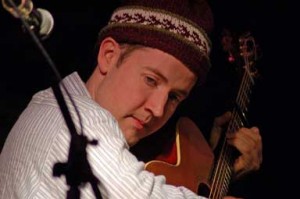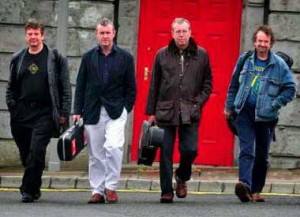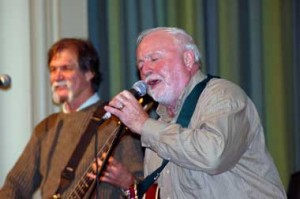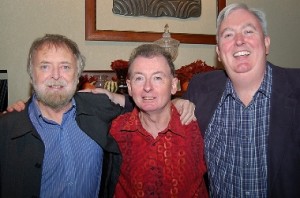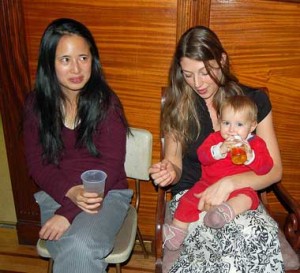When you listen to the scarily good Celtic harpers Gráinne Hambly and William Jackson, you might assume that they both started playing before they were out of nappies.
In reality, the Claremorris, County Mayo-born Hambly and Jackson, from just outside Glasgow, were both late bloomers … and their magnificent careers never might have begun at all were it not for a chance bit of window shopping.
“It was my sister who saw the harp,” Gráinne remembers. “She (Róisín) was 7 and I was going on 15. My sister saw it in the shop window and said she wanted to play.”
At the time, Gráinne wasn’t interested. She had started out on tin whistle, and had moved on to concertina, and really wanted no parts of harp. One day, though, the girls’ parents surprised them with a week-long school taught by famed Celtic harper Janet Harbison. It was one of those awkward surprises—like getting pajamas instead of a toy for Christmas. “When I found out, I wasn’t enthusiastic,” Gráinne says. But her apathy didn’t last long. “As soon as I started to play it, I loved it right away.”
For William “Billy” Jackson, the story was not quite the same. “I had started on piano when I was 11,” he says. “I ended up being a bass player in a band. I was in London in the ‘70s, and I saw a harp in a (shop) window.” Jackson had spent a lot of time in Ireland—his parents are from County Donegal—so the music of the harp was not new to him. But on that street in London, something clicked. “Just getting to see a harp up close … I sold my bass, and all my friends said I would never work again.”
Billy Jackson is doing just fine, thank you. It was a rough go at first, though. He took six lessons with a classical harpist. (A Celtic traditional player is a harper; a classical player is a harpist.) After that, he says, he couldn’t afford any more lessons for a time. He took a few more lessons much later on as a student at the Guildhall School in London, but finding someone to teach him specifically about Celtic harp was impossible. “Some (classical harpists) regard the Celtic harp as a toy, not the ‘real thing,’” says Jackson. “They’re reluctant to teach it. I was never taught to play triplets on the harp. Nobody taught me any of it.”
But Jackson, who also plays uilleann pipes, fiddle, bouzouki and tin whistle, somehow managed … and then some. In 1976, he became a founding member of Ossian, the famed Scottish traditional band. As a solo performer, he has played for audiences all over the world. He has recorded numerous CDs and is also the winner of the 1999 “Song for Scotland” competition for his composition “Land of Light.” (Listen to it here.)
Hambly’s early experience on the harp was more nurturing than Jackson’s. In Harbison, she found both a teacher and an ardent advocate for doing things the old-fashioned way. In traditional harp, there is no sheet music. Instead, the student watches and listens to the instructor as he or she plays a line. Then, the student repeats the line, and then another line, and so on, until the whole tune is committed to memory.
“That’s the traditional way to learn in Ireland,” says Hambly. “That’s how I learned, by ear. Janet brought harp teaching back to the roots.”
Age can work against you when you’re starting out on a musical instrument, but for Gráinne, it was a powerful incentive to learn. “Generally children do start learning early,” she says. “I was in a class with 7-year-olds. That was great motivation to learn quickly. Parents often ask me, ‘Is my child too old to start?’ I don’t think any age is too old, especially if you played another instrument first.”
Like Jackson, Gráinne also tours extensively throughout Europe and the U.S. She was a member of Harbison’s Belfast Harp Orchestra, as well as the Irish National Harp Ensemble and the National Folk Orchestra. She too has recordings under her belt. (Listen to An Draigheann, or “The Blackthorn.”)
Over the last couple of years, Jackson and Hambly have been touring together, giving audiences a sampling of harp music from both sides of the North Channel. You can hear them on October 29 in their “Masters of the Celtic Harp” concert at Trinity Church in Cherry Hill. The performance begins at 7.30 p.m.
Like their musical careers, their decision to tour together was a happy accident.
They were playing a concert in Asheville, N.C., two years ago, when, Jackson recalls, “at the end of the performance, “the organizer asked us to do a couple of tunes together.” They did, and the audience loved it. At the end of the concert, Gráinne says, “people came up to us and said ‘you should do more things together.’”
Gráinne, who knows so many players in the small village that is Irish traditional music, asked her friend and fellow harper Kathy DeAngelo of Voorhees to set up some concerts. Jackson and Hambly have been playing steadily together ever since.
And the sound is pretty wonderful—but it isn’t necessarily as effortless as it seems. “It’s difficult to play two harps together,” Jackson explains. “They have to be perfectly in tune, but there are so many more strings, it’s difficult. It’s not like playing fiddle together.”
Fortunately for Hambly and Jackson—and for us—they’re both skilled multi-instrumentalists.
“I’ll play concertina while Billy plays harp,” Gráinne says. “And sometimes, I’m playing the harp while Billy plays bouzouki. It’s a bit livelier.” (Listen to Hambly and Jackson play “Celia Connellan” and “Rectory Reel.”)
Editor’s Note: Gráinne’s new CD, “The Thorn Tree,” will be released Nov. 28. But you can get a sneak preview. A CD release party will be held Saturday, Oct. 28, at 7 p.m., at the Cooper River Yacht Club. For details, call Kathy DeAngelo at (856) 795-7637.

